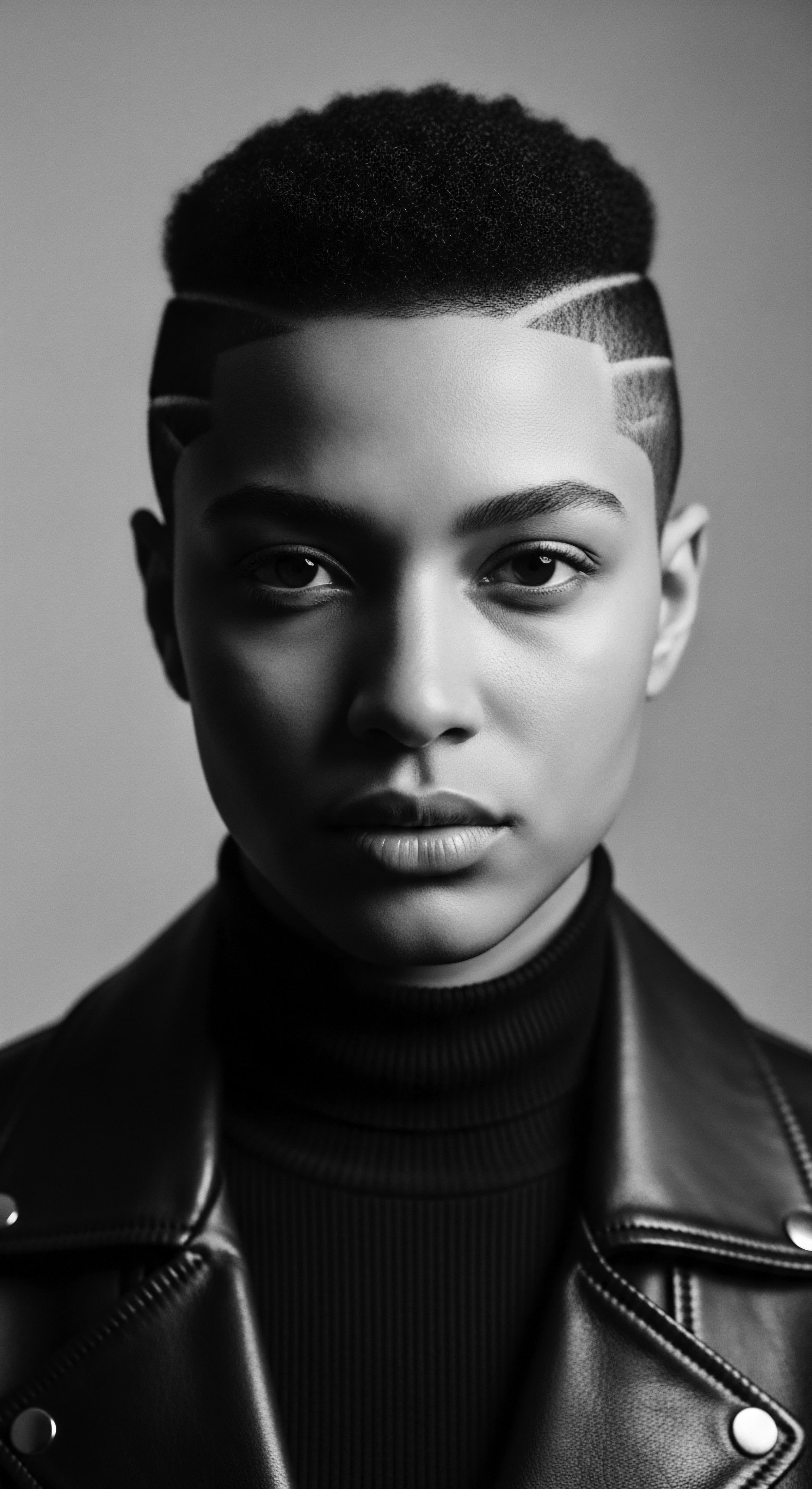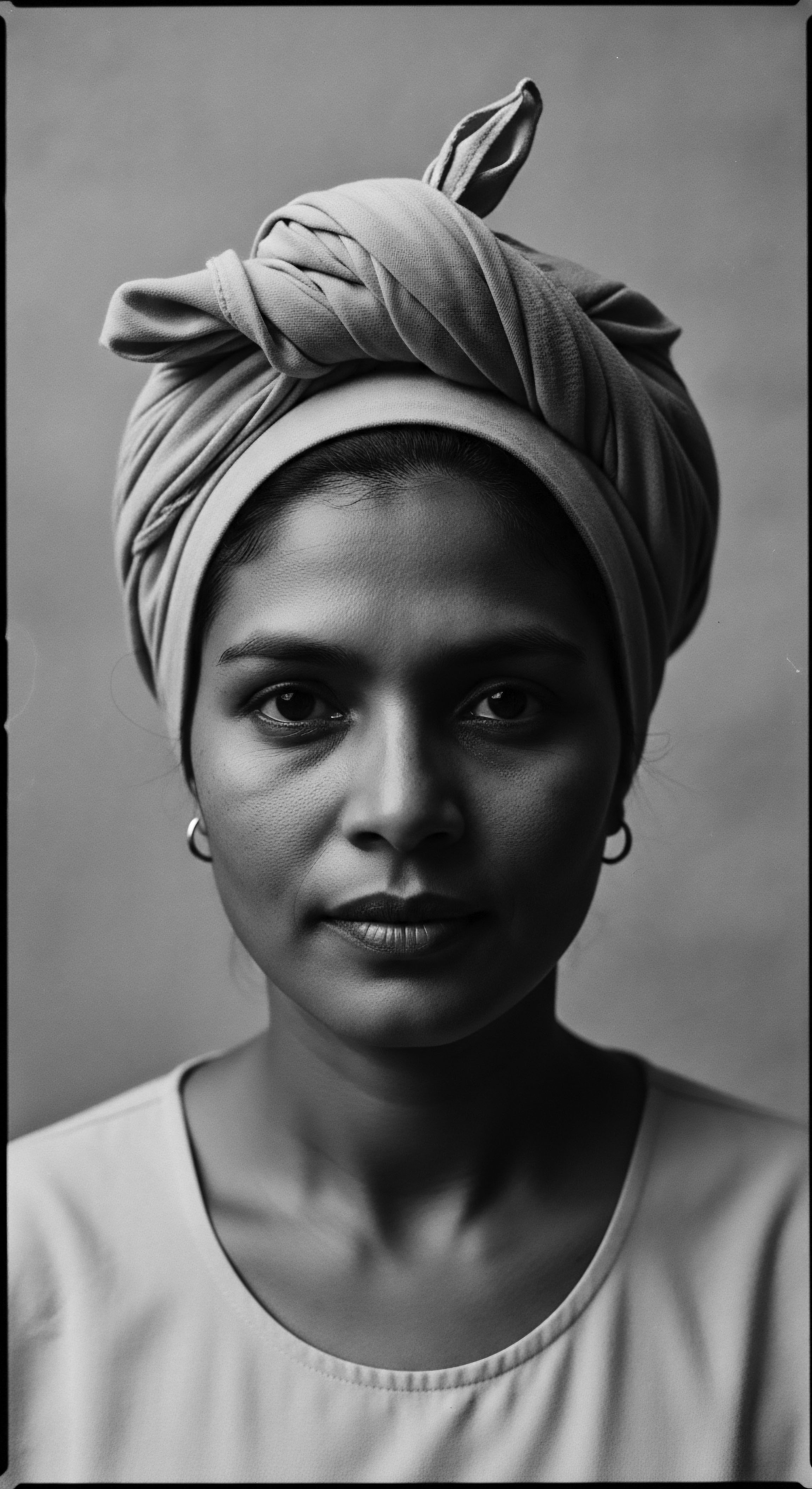
Roots
Consider for a moment the very strands that spring from one’s scalp, not simply as biological phenomena, but as living echoes of a lineage, a testament to journeys traversed and wisdom held across generations. Textured hair, in its glorious coils and kinks, its deep waves and spirited curls, carries within its very structure the whispers of ancestral memory. For those of us whose heritage weaves through the Black and mixed-race diaspora, hair is a chronicle, a vibrant symbol of resilience, beauty, and identity. The question of whether ancestral clay remedies can bestow hydration upon these unique strands reaches far beyond simple cosmetic concern; it asks us to acknowledge ancient knowledge, to discern how earth’s own gifts nurtured hair long before the advent of modern laboratories.
The exploration of clay’s affinity for hair finds its origin in the elemental biology of the strands themselves. Each curl, each coil, is a marvel, built from keratin proteins arranged in a particular way that dictates its shape and its inherent needs. The cuticle, that outermost layer of overlapping scales, guards the hair’s internal structure.
In textured hair, these scales often sit in a more lifted position, creating greater surface area and allowing moisture to escape with greater ease. This very architecture, a mark of distinct heritage, means hydration is not merely about dampness; it involves substances that can respectfully cloak the cuticle, infusing and retaining life-giving water.

What Is the Ancestral Relationship with Earth’s Minerals?
Across various ancestral practices, the earth itself was a primary source of nourishment and care. Soils, rich with minerals, were not seen as inert dirt but as potent healers and purifiers. Clays, in particular, were recognized for their remarkable ability to absorb, draw, and also, crucially, to deposit. Our forebears observed these qualities intimately, understanding how certain earths could draw impurities from the skin and hair, leaving a refreshed feeling.
This keen observation, passed down through oral tradition and lived practice, formed the bedrock of early hair care. It spoke to a knowing of the subtle interplay between the body and the natural world around it.
Take, for example, the widespread use of Rhassoul clay, also known as Moroccan Lava Clay or Ghassoul. Sourced from the ancient deposits within the Atlas Mountains of Morocco, this mineral-laden earth has been a staple in beauty rituals for centuries. Berber women, the indigenous inhabitants of Morocco, utilized this clay for generations as a natural cleanser and conditioner. It gained renown for its cleansing ability, removing excess sebum and product build-up without stripping the hair of its natural oils.
The mineral composition, high in silica, magnesium, calcium, and potassium, contributes to its remineralizing and softening attributes, making it particularly suited for supporting dehydrated hair and scalp. This is not simply a historical footnote; it highlights a profound understanding of natural properties, applied with wisdom.
Ancestral clay remedies invite us to reconsider the fundamental partnership between the earth’s elements and the inherent characteristics of textured hair.
The traditional understanding of hair “types” also influenced how these remedies were applied. While modern hair typing systems (like those using numbers and letters) are relatively recent constructs, ancestral communities recognized variations in hair texture and porosity through observation. A woman might know that a certain blend of clay and herbs was best for hair that felt dry and brittle, while another concoction served a hair type prone to excessive oil.
This classification was practical, rooted in the lived experience of maintaining healthy hair within one’s familial and communal lineage. The essential lexicon of textured hair, then, was often an oral one, spoken through the preparation and application of these potent natural ingredients, each movement a word in an ongoing conversation with heritage.
Beyond Moroccan Rhassoul, we find diverse instances of earth-based hair care. The Himba people of Namibia, for instance, have a tradition of creating ‘otjize’, a paste made from red ochre clay, butter fat, and aromatic herbs. This mixture serves not just as a cosmetic adornment, symbolizing beauty and social status, but also as a protective layer against the harsh sun and dry environment.
It’s a compelling example of how ancestral remedies provided both aesthetic and functional benefits, contributing to hair health by forming a barrier that minimized moisture loss and offered a form of natural sun protection. This practice illustrates a deep, integrated knowledge of environmental challenges and effective solutions drawn from the immediate surroundings.

Ritual
The application of ancestral clay remedies to textured hair was rarely a solitary, quick task. It was, more often, a thoughtful undertaking, a ritual steeped in intention, often communal, and always connected to well-being. These practices were woven into the daily rhythms of life, reflecting a profound respect for the body and its natural needs. The act of preparing the clay, perhaps grinding it, mixing it with water, oils, or botanical infusions, was itself a form of meditation, a quiet acknowledgement of the earth’s generosity.

How Were Ancestral Clays Prepared for Hair Conditioning?
The preparation of clay for hair conditioning varied, yet certain principles remained constant. Cleanliness of the material was paramount. The earth was collected, often dried, and then finely pulverized. The true artistry lay in the additions.
Water, of course, was the most fundamental mixer, transforming dry earth into a soft, pliable paste. But other elements, chosen for their known properties, would join this blend.
- Botanical Infusions ❉ Herbs like rosemary or hibiscus, steeped in water, added their beneficial properties and often a pleasing scent to the clay mixture.
- Nourishing Oils ❉ Plant-derived oils, such as argan oil in Morocco or shea butter in West Africa, were commonly incorporated to enhance the moisturizing and softening qualities of the clay. These oils also aided in the ease of application and rinsing.
- Natural Acids ❉ Sometimes, acidic elements like fermented fruit juices or even diluted vinegar were included. These could help balance the pH of the mixture and contribute to the clay’s cleansing action, as seen in modern practices using apple cider vinegar with Bentonite clay.
The consistency of the mixed clay was important. It needed to be smooth enough to coat hair strands evenly, allowing the minerals to interact with the hair shaft. This process of combining and blending was a testament to the empirical knowledge accumulated over centuries, where generations learned through careful observation and shared wisdom. The hands that mixed the clay were often the same hands that later worked the mixture into the hair, performing detangling and nurturing movements.
Consider the technique. Unlike modern shampoos, clay was not meant to create a lather. Its cleansing power derived from its ionic charge and its mineral composition, which could absorb impurities and gently cleanse the scalp without stripping natural oils. For textured hair, this non-stripping action is especially beneficial, as harsh detergents can exacerbate dryness and disrupt the natural curl pattern.
The application often involved sectioning the hair, working the clay from roots to ends, and allowing it to sit, much like a modern hair mask. This allowed the clay to interact with the hair and scalp, depositing minerals and drawing out build-up.
The historical use of clay in hair care illustrates a continuity of ingenuity, adapting earth’s properties for cleansing, softening, and shaping.
The Himba women’s use of otjize, mentioned earlier, transcends simple hair conditioning; it is an elaborate art form that shapes identity. The mixture of ochre clay, butterfat, and herbs is applied to intricately braided hair, often lengthened with natural fibers. This application requires skill and patience, often taking hours, and is a deeply cultural practice that marks rites of passage and social status.
The clay acts as a sealant, helping to retain moisture within the hair while providing protection from environmental elements. This practice demonstrates a sophisticated understanding of hair needs within a specific context, where hydration is achieved through a protective, occlusive coating.
The continuity of these practices, even in a modified form, is evident today. Many contemporary natural hair enthusiasts use Rhassoul and Bentonite clays for their clarifying, softening, and curl-defining properties. The scientific observation that these clays can absorb excess oil and product residue, while also conditioning the hair and enhancing curl patterns, echoes the ancestral understanding of their benefits. This lineage of care, from the ancient mixing bowls to modern clay masks, highlights an enduring wisdom that transcends time, a tender thread connecting us to past generations who found solace and sustenance in the earth.
| Aspect of Care Primary Function |
| Ancestral Practices (e.g. Rhassoul, Himba) Cleansing, protecting, conditioning, spiritual connection, social marking. |
| Modern Adaptations of Clay Care Clarifying, detoxifying, curl definition, adding moisture. |
| Aspect of Care Ingredients Commonly Combined |
| Ancestral Practices (e.g. Rhassoul, Himba) Water, plant oils (argan, shea), herbs, ochre, animal fats. |
| Modern Adaptations of Clay Care Water, apple cider vinegar, essential oils, carrier oils, botanical extracts. |
| Aspect of Care Application Focus |
| Ancestral Practices (e.g. Rhassoul, Himba) Whole head, roots to tips, often woven into elaborate styles; communal. |
| Modern Adaptations of Clay Care Pre-shampoo treatments, masks for scalp and strands; individual. |
| Aspect of Care Hydration Mechanism |
| Ancestral Practices (e.g. Rhassoul, Himba) Mineral absorption, protective layer, gentle cleansing, oil retention. |
| Modern Adaptations of Clay Care Moisture absorption by clay, sealing with added oils, pH balancing. |
| Aspect of Care The enduring efficacy of clays for textured hair bridges ancient knowledge with current understanding, underscoring heritage as a constant guide. |

Relay
To grasp the capacity of ancestral clay remedies to hydrate textured hair, one must consider the delicate dance between elemental composition and the unique needs of hair. Clays, at their core, are layered silicate minerals, formed over millennia through the weathering of rocks. It is their molecular structure and ionic charge that grant them their remarkable properties. Many clays carry a negative charge, allowing them to attract and bind positively charged impurities, toxins, and product build-up on the hair and scalp.
This cleansing action, however, is distinct from that of harsh sulfates, which can strip hair of its natural oils, leading to dryness. Clays, by contrast, cleanse without removing the vital lipid layer, thus helping to maintain the hair’s moisture balance.

How Do Clay Minerals Influence Hair Moisture?
The hydration that clays impart transcends simply feeling soft. It involves a complex interplay of mineral exchange and the creation of a protective environment for the hair shaft. Rhassoul clay, for instance, is rich in minerals like silica, magnesium, potassium, and calcium. When mixed with water and applied to hair, these minerals are thought to contribute to strengthening the hair shaft and promoting elasticity, which in turn reduces breakage – a significant concern for textured hair prone to dryness.
The presence of these minerals can also influence the hair’s ability to absorb and retain water. Some theories suggest that clays can bind water molecules, releasing them slowly, or that their presence on the hair shaft helps to reduce overall water evaporation from the strand.
A study published in the Iranian Journal of Public Health noted that Bentonite clay could help make sheep wool grow quicker and softer. While this specific finding pertains to animal fiber, it offers a glimpse into the softening and conditioning capabilities of clays, properties that align with observed benefits for human hair. For textured hair, this softening capacity is vital, as it can improve manageability and ease detangling, reducing mechanical damage that often leads to hair loss and stunted growth. The unique charge of Bentonite clay allows it to draw out impurities and toxins, creating a clean slate for moisture to adhere to and penetrate the hair shaft.
The scientific understanding of clay’s properties validates what ancestral wisdom knew intuitively ❉ these earth-born minerals offer a distinct path to cleansing and hydrating textured strands.
Beyond the direct mineral interaction, clays contribute to hair hydration by promoting a healthy scalp. A clean, balanced scalp is foundational to healthy hair growth and moisture retention. Clays, with their absorbent properties, can help regulate sebum production, clear clogged pores, and soothe scalp irritation.
This creates an optimal environment for hair follicles to function effectively, contributing indirectly but significantly to the overall moisture levels of the hair. This understanding of scalp health as an integral part of hair wellness is a direct continuation of ancestral philosophies, where holistic care addressed the root of an issue, not just its visible symptoms.

What Benefits Do Clays Offer Beyond Simple Cleansing?
The journey of ancestral clay remedies from ancient traditions to contemporary practice highlights their multifaceted utility. They are not merely cleansing agents; they function as restorative treatments that address some of the fundamental challenges faced by textured hair.
- Mineral Enrichment ❉ Clays provide trace elements and mineral salts that nourish the hair fiber, contributing to its overall strength and resilience.
- Curl Definition ❉ Many users of clays, particularly Bentonite and Rhassoul, report enhanced curl clump and definition following use. The removal of buildup allows natural curl patterns to rebound, and the softening effect promotes coil formation.
- Detangling Aid ❉ The slippery consistency of hydrated clay can provide excellent slip, making detangling significantly easier, thus minimizing breakage during the wash process. This characteristic is especially important for textured hair, which is prone to tangles and knots.
- Scalp Balancing ❉ Clays help to normalize and balance the scalp, absorbing excess sebum without over-drying, which can be particularly beneficial for oily or combination scalps.
The enduring practice of using clays in hair care, from the ancient baths of Morocco to contemporary deep conditioning treatments, serves as a powerful testament. It illustrates how traditional knowledge, often dismissed as folklore, holds profound scientific validity. The historical narrative of clay remedies is not a static one, but a living archive, continuously interpreted and reaffirmed by modern understanding. This ongoing dialogue between the past and the present ensures that the wisdom of our ancestors continues to shape and inform the journey of textured hair care.

Reflection
As we draw breath from this deep exploration, the question of whether ancestral clay remedies hydrate textured hair finds its chorus in resounding affirmation. These earth-given gifts, cherished and applied by hands across centuries, carry an ancestral legacy that speaks to the profound wisdom embedded in the communities that first recognized their powers. The very act of turning to clay for hair care is an act of reconnection, an honoring of a heritage rich with ingenious solutions and intimate understandings of the natural world.
For the textured hair communities, whose strands have long been a canvas for identity and a chronicle of survival, ancestral clay remedies offer more than physical benefits. They provide a tangible link to a past where self-care was often intertwined with self-preservation and cultural expression. The journey of a single strand, from its birth at the scalp to its eventual release, holds stories – stories of resilience, of beauty forged in challenges, and of an unwavering commitment to wholeness.
The wisdom of those who first mixed earth with water, discerning its power to cleanse and soften, to protect and adorn, persists, a beacon for our contemporary quests for authenticity and well-being. This knowledge forms a living, breathing archive, continually teaching us the depth of the soul found within each strand.

References
- Carretero, M. I. Gomes, C. S. & Tateo, F. (2006). Clays in medicine and cosmetics. In E. G. F. S. B. F. E. M. J. L. P. B. L. C. I. S. A. F. A. I. G. A. M. H. S. (Eds.), Developments in Clay Science (Vol. 1, pp. 581–609). Elsevier.
- El Bakkari, M. (2007). Moroccan Ghassoul clay ❉ Historical, chemical, and industrial uses. Geology and Chemical Society of Morocco, 5, 1-10.
- Fathi, M. & Al-Marashdeh, A. I. (2018). Physicochemical and Technological Properties of Jordanian Clays for Cosmetical and Pharmaceutical Applications. Jordan Journal of Earth and Environmental Sciences, 9 (3), 209-220.
- Mohammed, A. A. & Al-Marashdeh, A. I. (2020). Cosmetic clays ❉ Minerals in skin and hair care. International Journal of Pharmaceutical Sciences Review and Research, 65 (1), 1-8.
- Saad, F. & Benkhadra, A. (2019). The Moroccan Rhassoul Clay ❉ A Review on its Cosmetic and Pharmaceutical Applications. Journal of Advanced Research in Biotechnology, 4 (2), 1-6.
- Sekhri, S. & Arora, S. (2021). Clay-based cosmetics ❉ An overview. Journal of Cosmetic Science, 72 (2), 1-10.
- Voeks, R. A. & Rashford, J. (2012). African Ethnobotany in the Americas. Springer. (This source speaks broadly to African ethnobotany in the Americas, supporting the cultural history aspect for Himba practices and general ancestral knowledge transfer.)
